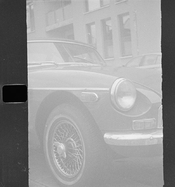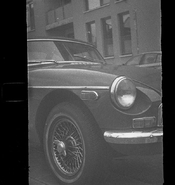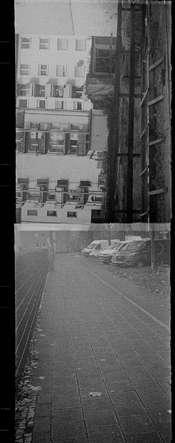cannotShootStraight
Member
I am struggling for a few days now to get the first decent results from my Kiev Vega 2.
I've loaded the camera multiple times with 16mm Kodak Double-X B&W-film.
I use the CineStill D96 powder developer which I set up with 1L of tap water, same with ADOFIX P II, approximately 2 weeks ago.
My process looks like this:
- Filling ~22°C water into my paterson tank and agitate a little bit
- Emptying the tank and filling 300ml of D96 (20°C)
- Develop for 4min with agitations every minute
- Pour the developer back and rinse with 22°C (I couldn't get it closer to 20°C) water multiple times
- Fixing for 11min (20°C, agitations every minute)
- Rinse with up to 30 agitations 4 times
- Put some dish soap into the paterson tank
- Hang to dry
I have attached an image of a piece of film I converted with Negative Lab Pro (no contrast added).
I've been noticing black spotted areas on multiple pictures. At first I thought they might be the result of accidental finger prints while I loaded the film.
But I've become more careful and the spotted areas persisted. Could this be deposits from tap water? The fluid arrangement on the film in particular makes me think of that as the spotted areas flow across multiple images. What's strange is that from a certain image onwards the spotted areas disappear.
I am also kinda disappointed with the contrast. The results are low contrast even though I developed some films at around 6 and up to 8 minutes and the results didn't get much better.
I attached one image without added contrast and then after I added a bunch of contrast, reduced brightness and reduced the shadows.
Is this just the way this film behaves? Am I using the wrong developer? I controlled the exposure using a light meter app on my phone.
I've loaded the camera multiple times with 16mm Kodak Double-X B&W-film.
I use the CineStill D96 powder developer which I set up with 1L of tap water, same with ADOFIX P II, approximately 2 weeks ago.
My process looks like this:
- Filling ~22°C water into my paterson tank and agitate a little bit
- Emptying the tank and filling 300ml of D96 (20°C)
- Develop for 4min with agitations every minute
- Pour the developer back and rinse with 22°C (I couldn't get it closer to 20°C) water multiple times
- Fixing for 11min (20°C, agitations every minute)
- Rinse with up to 30 agitations 4 times
- Put some dish soap into the paterson tank
- Hang to dry
I have attached an image of a piece of film I converted with Negative Lab Pro (no contrast added).
I've been noticing black spotted areas on multiple pictures. At first I thought they might be the result of accidental finger prints while I loaded the film.
But I've become more careful and the spotted areas persisted. Could this be deposits from tap water? The fluid arrangement on the film in particular makes me think of that as the spotted areas flow across multiple images. What's strange is that from a certain image onwards the spotted areas disappear.
I am also kinda disappointed with the contrast. The results are low contrast even though I developed some films at around 6 and up to 8 minutes and the results didn't get much better.
I attached one image without added contrast and then after I added a bunch of contrast, reduced brightness and reduced the shadows.
Is this just the way this film behaves? Am I using the wrong developer? I controlled the exposure using a light meter app on my phone.

















